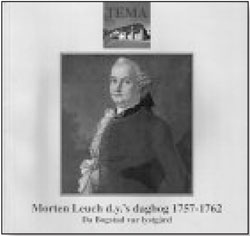Book review: La dolce vita in 18th century Norway
Michael 2006;3:98–9.
Arnesen F. (ed.) Morten Leuch d.y.’s dagbog 1757–1762 – Da Bogstad var lystgård. Oslo: Bogstad Stiftelse, 2006. 132 pp. Ill. ISBN: 82–9939939–9. Price: NOK 150,-.

Tourists in Oslo, interested in 18th century history, should include a visit to the Bogstad manor outside the city during their stay. Situated in a beautiful park on the slopes of a lake, surrounded by a peasant landscape with forests, fields and meadows with grazing livestock, the old buildings have been preserved and are today open to the public as a museum and cultural centre.
From 1757 until his death, the rich merchant Morten Leuch d.y. (the younger) (1732–1768) was the owner of Bogstad. He used the estate as a country residence, where he took his friends and business partners for dinners and parties. His widow Mathia Leuch, born Collett (1737–1801) remarried, and her second husband was the merchant Bernt Anker ( 1746–1805). In 1773 she sold Bogstad to his younger brother Peder Anker (1749–1824) – also a central person in Norway at the end of the 18th century, and in the beginning of the 19th, when he even served as a Norwegian prime minister in Stockholm.
However, it was in the years under Morten Leuch Bogstad most typically served as a resort. For the period 1757–1762 a diary exists, telling about the daily life on Bogstad. It has the form of a protocol, perhaps resembling what Norwegians often have till this day in their cabins or second homes – a «hyttebok» («log book for the hut»). The protocol has been transcribed from an earlier copy, and the editor has added useful notes, family charts and illustrations.
The reader finds a text which in a way is surprisingly monotonous; it tells about a seemingly endless series of dinners, parties and outings. Guests are coming and guests are leaving. Beautiful young ladies are courted by visiting gentlemen etc. etc. However, these stories call for an interest which goes beyond their contents: They tell about the handful of wealthy families which in fact ruled Norway of the time. And these families were intermingled with numerous ties, as marriage partners very often were found in the close circles. Many of these people led a private life obviously filled with so much leisure that the elite exerting the real power in society in fact was even less numerous than the number of families should indicate – mostly counting just the few persons like Morten Leuch, Peder Anker, Bernt Anker and others, those who combined the role of the hard and progressive businessman with that of the party lion.
Professor of medical history
Institute of general practice and community healt
University of Oslo
Po.box 1130 Blindern
N-0318 Oslo
oivind.larsen@medisin.uio.no
